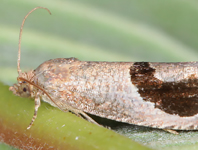Abstract
The life cycle of calanoid copepods consists of eggs hatching into nauplii (6 stages) which then moult into copepodids (5 stages), followed by the final moult into the adult female and male. The family Diaptomidae contains two subfamilies, Diaptominae and Paradiaptominae, with paradiaptomids almost exclusively consisting of African taxa. The copepodid stages III, IV and V were described for some freshwater diaptomine genera (i.e., Eudiaptomus Kiefer, 1932, Aglaodiaptomus Light, 1938, Skistodiaptomus Light, 1939, Leptodiaptomus Light, 1938, Megadiaptomus Kiefer, 1936 and Diaptomus Westwood, 1836). Copepods collected from Turfloop Dam, South Africa, with a plankton net were fixed and preserved in 70% ethanol. Calanoid copepods were studied under stereo- and light microscopes, using the wooden slide technique and features drawn. Examined specimens were identified as the copepodid stages of two African species, Lovenula falcifera (Lovén, 1845) and Metadiaptomus colonialis (van Douwe, 1914). Copepodids of the two species can be distinguished by their body size and the structure and size of the maxillipeds. The description and illustrations of three postnaupliar stages (CoIII, CoIV and CoV) are provided for both species. The identification of different stages is based on the number of urosomites, antennule development, the segmentation of legs 1–4, and the development of the fifth leg. These copepodids are compared with those of other described diaptomid genera.
References
Baird, W. (1850) The natural history of the British Entomostraca. The Ray Society, London, viii + 364 pp.
https://doi.org/10.5962/bhl.title.1807
Comita, G.W. & McNett, S.J. (1976) The postembryonic developmental instars of Diaptomus oregonensis Lilljeborg, 1889 (Copepoda) Crustaceana, 30 (2), 123–163.
https://doi.org/10.1163/156854076X00530
Comita, G.W. & Tommerdahl, D.M. (1960) The postembryonic development instars of Diaptomus siciloides Lilljeborg. The Journal of morphology, 107, 297–355.
https://doi.org/10.1002/jmor.1051070305
Douwe, C. (1912) Ost-afrikanische Susswasser-Copepoden. In: Spengel, J.W. (Ed.), Zoologische Jahrbücher. Vol. 33. von Gustav Fischer, Jena, pp. 1–8.
Einsle, U.K. (1989) The Identification of Copepodid Instars of Some Calanoid and Cyclopoid Copepods of Lake Konstanz, Federal Republic of Germany. Crustaceana, 57 (1), 79–87.
https://doi.org/10.1163/156854089X00374
Ferrari, F.D. (1988) Developmental patterns in numbers of ramal segments of copepod post-maxillipedal legs. Crustaceana, 54 (3), 256–293.
https://doi.org/10.1163/156854088X00168
Gurney, R. (1931) British fresh-water copepoda. Vol. 1. Ray Society, London, pp. 115–125.
https://doi.org/10.5962/bhl.title.82138
Hart, R.C. (1991) Food and suspended sediment influences on the naupliar and copepodid durations of freshwater copepods: comparative studies on Tropodiaptomus and Metadiaptomus. Journal of Plankton Research, 13 (3), 645–660.
https://doi.org/10.1093/plankt/13.3.645
Humes, A.G. & Gooding, R.U. (1964) A method for studying the external anatomy of copepods. Crustaceana, 6 (3), 238–240.
https://doi.org/10.1163/156854064X00650
Huys, R. & Boxshall, G.A. (1991) Copepod evolution. The Ray Society, London, 1–468 pp.
Kajihara, T. & Nakamurs, K. (1985). Lifespan and oviposition of the parasitic copepods, Pseudomykola spinosus under rearing conditions. Marine Biology, 87, 55–60.
https://doi.org/10.1007/BF00397005
Kamal, A. & Armitage, K.B. (1967) External morphology of adult and copepodid stages of Diaptomus clavipes Schacht 1897. University of Kansas science bulletin, 47, 559–573.
Kiefer, F. (1936) Freilebende Suss-und Salzwasserco-pepoden von der Insel Haiti. Archiv fur Hydrobiologie, 30, 263–317.
Kiefer, F. (1932) Neue Diaptomiden und Cyclopiden aus Französisch Westafrika. Voyage de C.H. Alluaud et P. A. Chappuis en Afrique Occidentale francaise. Bulletinul Societatei de Stiinte din Cluj, 6, 524–527.
Light, S.F. (1938) New subgenera and species of diaptomid Copepoda from the inland waters of California and Nevada. University of California Publications in Zoology, 43, 67–78.
Light, S.F. (1939) New American subgenera of Diaptomus Westwood (Copepoda, Calanoida). Transactions of the American Microscopical Society, 58 (4), 473–484.
https://doi.org/10.2307/3222789
Lovѐn, S. (1845) Fyra nya arter af Sötvattens Crustacéer fran Södra-Afrika. Kongliga Svenska vetenskapsakademiens handlingar, 427–439.
Methuen, P.A. (1910) On a collection of freshwater Crustacea from the Transvaal. Proceedings of the Zoological Society of London, 1, 148–166.
https://doi.org/10.1111/j.1096-3642.1910.tb01889.x
Mnisi, P. & Dippenaar, S.M. (2019) A report of the free-living freshwater planktonic copepods from an ephemeral pool in Limpopo Province, South Africa, with the description of Microcyclops raynerae n. Sp. Crustaceana, 92 (5), 555–575.
https://doi.org/10.1163/15685403-00003894
Pinel-Alloul, B. & Lamoureux, J. (1988) Developpement post-embryonnaire du Copepode Calanoide Diaptomus (Aglaodiaptomus) leptopus S. A. Forbes, 1882 II. Phases copepodite et adulte. Crustaceana, 54 (2), 171–195.
https://doi.org/10.1163/156854088X00087
Reddy, Y.R. & Devi, C.R. (1985) The complete postembryonic development of Megadiaptomus hebes Kiefer, 1936 (Copepoda, Calanoida) reared in the laboratory. Crustaceana, 48 (1–3), 40–63.
https://doi.org/10.1163/156854085X00710
Rayner, N.A. (2001) Copepoda. In: Day, J.A. de Moor, I.J. Stewart, B.A. & Louw, A.E. (Eds.), Guide to freshwater invertebrates of Southern Africa. Vol. 3. Crustacea II. Water Research Commission, Pretoria, pp. 78–123.
Rayner, N.A. (1992) Revision of the freshwater diaptomid genus Lovenula (Crustacea, Copepoda) in Africa. Annals of the South African Museum, 101, 297–332.
Sars, G.O. (1903) An account of the Crustacea of Norway. Vol. 4. Copepoda Calanoida. Bergen Museum, Bergen, 171 pp.
Schacht, F.W. (1897) s.n. In: The North American species of Diaptomus. Illinois state laboratory of Natural History, Illinois, pp. 178–181.
https://doi.org/10.21900/j.inhs.v5.414
Shen, C.J. & Chang, C.C. (1965) Larval development of Metadiaptomus asiaticus Ulganin. Chinese Journal of Oceanology and Limnology, 7, 141–150.
Shih, C.T. & Maclellan, D.C. (1977) Descriptions of copepodites stages of Diaptomus (Leptodiaptomus) nudus Marsh 1904 (Crustacea Copepoda). Canadian Journal of Zoology, 55, 912–921.
https://doi.org/10.1139/z77-119
Uljanin, V. (1875) Rakoobraznye. Puteshestvie Fedchenko v Turkestan. Crustaces. Voyage de Fedchenko au Turkenstan, 2 (6), 23–41.
Van Douwe, C. (1914) Copepoda. In: Michaelsen, W. (Ed.), Beiträge zur Kenntnis der Land-und Süsswasserfauna Deutsch-Südwestafrikas. Ergebnisse der Hamburger deutsche-südwestafrikanischen Studienreise 1911. Vol. 1. L. Friederichsen & Co, Hamburg, pp. 93–103.
https://doi.org/10.1002/mmnd.48019140418
Westwood, J.O. (1836) Cyclops. In: Partington, C.F. (Ed.), The British Encyclopedia of Natural History. Vol. 2. Orr and Smith, London, pp. 227–228.
Williamson, C.E. (1991) Copepoda. In: Thorp, J.H. & Covich, A.P. (Eds.), Ecology and Classification of North American Freshwater Invertebrates. Academic Press, San Diego, California, pp. 787–822.


